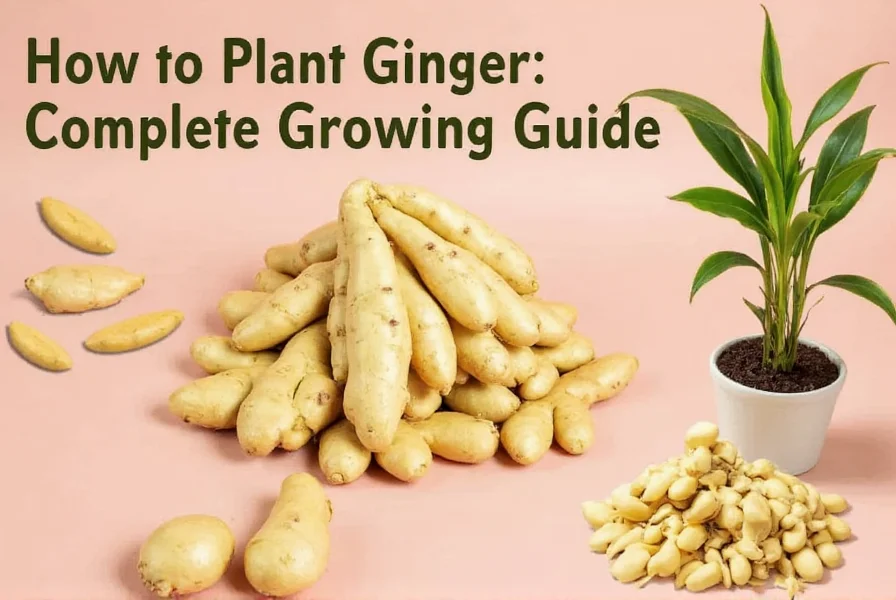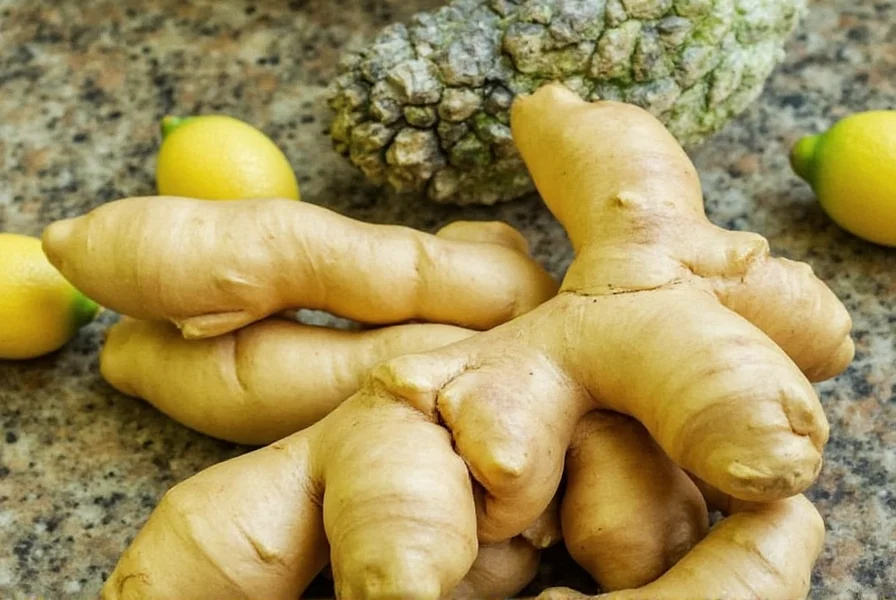Growing your own ginger at home is simpler than many gardeners realize. This tropical perennial, scientifically known as Zingiber officinale, thrives in warm, humid conditions but can be cultivated successfully in various climates with proper care. Whether you're working with limited space in an urban apartment or have a sprawling backyard garden, ginger offers both culinary and ornamental value with its attractive reed-like foliage and fragrant flowers.
Why Grow Ginger at Home
Homegrown ginger provides superior flavor and freshness compared to store-bought options, which are often several weeks old by the time they reach your kitchen. Freshly harvested ginger contains higher concentrations of gingerol, the compound responsible for its distinctive flavor and health benefits. Additionally, growing ginger requires minimal space—a single rhizome can produce multiple harvests over time, making it an economical choice for home gardeners.
Selecting Quality Ginger Rhizomes for Planting
The foundation of successful ginger cultivation begins with selecting healthy planting material. Look for plump, firm rhizomes with multiple visible 'eyes' or growth buds. These eyes appear as small, rounded protrusions along the rhizome's surface. Organic grocery store ginger often works well for planting, as conventionally grown ginger may be treated with growth inhibitors.
Before planting, soak your ginger rhizome in lukewarm water for several hours to encourage sprouting. Then, cut the rhizome into 1-2 inch sections, ensuring each piece has at least one eye. Allow the cut sections to air dry for 24-48 hours to form a protective callus, which helps prevent rot after planting.
| Ginger Variety | Best For | Flavor Profile | Maturity Time |
|---|---|---|---|
| Common Yellow Ginger | General cooking | Strong, pungent | 8-10 months |
| African Ginger | Medicinal uses | Intensely spicy | 10-12 months |
| Blue Hawaiian | Raw consumption | Milder, citrus notes | 9-11 months |
| Indian Ginger | Cooking and preservation | Balanced heat | 8-9 months |
Optimal Planting Time for Ginger
The best time to plant ginger depends on your climate zone. In tropical regions (USDA zones 9-12), ginger can be planted year-round, though the rainy season provides ideal moisture conditions. For temperate climates, plant ginger rhizomes indoors 6-8 weeks before your last expected frost date, then transplant outdoors when soil temperatures consistently reach 70°F.
Indoor gardeners can plant ginger at any time of year, provided they can maintain temperatures between 70-90°F and humidity levels above 50%. Ginger grows most actively during spring and summer months, slowing significantly during cooler fall and winter periods.
Soil Requirements for Healthy Ginger Growth
Ginger thrives in rich, well-draining soil with high organic matter content. The ideal soil pH ranges from 5.5 to 6.5—slightly acidic conditions that mimic its natural tropical forest floor habitat. Heavy clay soils should be amended with compost and perlite to improve drainage, while sandy soils benefit from added organic matter to retain moisture.
For container planting, use a high-quality potting mix blended with 30% compost and 20% perlite or coarse sand. Avoid garden soil in containers, as it compacts too easily and may contain pathogens. Ginger prefers loose, friable soil that allows its rhizomes to expand freely as they grow.
Container vs. Ground Planting: Which Is Better?
Both container and ground planting offer advantages for ginger cultivation. Container growing provides greater control over soil conditions and makes it easier to move plants to optimal light conditions. Use containers at least 12 inches deep with adequate drainage holes—terra cotta pots work well as they allow soil to breathe.
For in-ground planting, choose a location with dappled sunlight or morning sun with afternoon shade. Ginger naturally grows under forest canopies, so direct afternoon sun can scorch its delicate leaves. Prepare the planting area by loosening soil to a depth of 12 inches and incorporating 3-4 inches of compost.
Step-by-Step Ginger Planting Instructions
Follow these detailed steps for successful ginger planting:
- Prepare your planting medium by mixing equal parts potting soil, compost, and perlite
- Fill your container or prepared garden bed with soil, leaving 2-3 inches of space below the rim
- Place ginger rhizome sections horizontally with eyes facing upward
- Cover with 2-4 inches of soil (deeper in hotter climates)
- Water thoroughly until moisture drains from the bottom
- Maintain consistent soil moisture—never allowing the soil to dry completely
- Position in warm location with indirect light until sprouts emerge (3-6 weeks)
Essential Care Requirements for Thriving Ginger Plants
Ginger requires consistent moisture but cannot tolerate waterlogged conditions. Water when the top inch of soil feels dry, providing enough water to moisten the entire root zone. During active growth (spring and summer), fertilize monthly with a balanced, organic liquid fertilizer diluted to half strength.
Maintain humidity levels above 50% by misting plants regularly or placing containers on pebble trays filled with water. Ginger benefits from monthly applications of compost tea to provide gentle, consistent nutrition. As plants grow, you may need to add additional soil to cover emerging rhizomes, which helps protect them from sun exposure.

Troubleshooting Common Ginger Growing Problems
Ginger cultivation occasionally presents challenges that can be addressed with proper knowledge:
- Yellowing leaves: Usually indicates overwatering or poor drainage. Reduce watering frequency and ensure proper soil aeration.
- Slow growth: Often caused by cool temperatures or insufficient light. Move to warmer location with brighter indirect light.
- Rhizome rot: Results from waterlogged soil. Remove affected portions and improve drainage immediately.
- Leaf spot diseases: Treat with organic copper fungicide and improve air circulation around plants.
- Pests: Aphids and spider mites can be controlled with insecticidal soap sprays.
Harvesting Your Homegrown Ginger
You can begin harvesting ginger 8-10 months after planting, when the leaves begin to yellow and die back naturally. For a continuous harvest, you can 'tip' harvest by carefully digging around the edges of the plant and removing only a portion of the rhizome, allowing the plant to continue growing.
For full harvest, stop watering 1-2 weeks before digging to allow the rhizomes to mature. Gently dig up the entire plant, being careful not to damage the delicate rhizomes. Clean off excess soil, but avoid washing with water, which can promote mold. Allow harvested ginger to cure in a shaded, well-ventilated area for 2-3 days before storing.
Storing Your Ginger Harvest
Properly stored ginger can remain fresh for several weeks. Keep unpeeled ginger in a paper bag in the refrigerator's vegetable drawer for up to 3 weeks. For longer storage, freeze peeled ginger chunks in an airtight container for up to 6 months—frozen ginger grates easily without thawing.
Drying ginger preserves it for even longer storage. Slice ginger thinly and dehydrate at 135°F until completely dry and brittle, then store in an airtight container away from light. Dried ginger retains its flavor and medicinal properties for up to a year.
Frequently Asked Questions
Can I plant store-bought ginger root?
Yes, you can plant store-bought ginger, but organic ginger works best as conventional grocery store ginger is often treated with growth inhibitors. Look for plump rhizomes with multiple visible 'eyes' or growth buds. Soak the ginger in lukewarm water for several hours before planting to encourage sprouting.
How long does it take for ginger to grow from planting to harvest?
Ginger typically takes 8-10 months to reach full maturity from planting. You'll see sprouts emerge in 3-6 weeks, but the rhizomes need the full growing season to develop properly. In tropical climates, ginger may mature slightly faster (7-8 months), while cooler climates may require up to 12 months for a full harvest.
Does ginger need full sun or shade to grow properly?
Ginger prefers partial shade or dappled sunlight, mimicking its natural forest floor habitat. In most climates, morning sun with afternoon shade produces the best results. Direct afternoon sun can scorch ginger's delicate leaves, especially in hot climates. Indoor plants should receive bright, indirect light for 6-8 hours daily.
How often should I water ginger plants?
Water ginger when the top inch of soil feels dry, typically 1-2 times per week depending on temperature and humidity. During active growth (spring and summer), maintain consistent moisture without waterlogging. Reduce watering in fall as plants prepare for dormancy. Container plants generally need more frequent watering than in-ground plants.
Can I grow ginger indoors year-round?
Yes, ginger grows well indoors year-round with proper conditions. Maintain temperatures between 70-90°F, humidity above 50%, and provide bright, indirect light for 6-8 hours daily. Use containers with good drainage and water when the top inch of soil dries out. Indoor ginger may grow more slowly than outdoor plants but will still produce harvestable rhizomes in 10-12 months.











 浙公网安备
33010002000092号
浙公网安备
33010002000092号 浙B2-20120091-4
浙B2-20120091-4